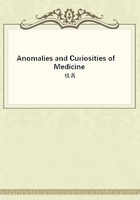
第73章
MAJOR TERATA.
Monstrosities have attracted notice from the earliest time, and many of the ancient philosophers made references to them. In mythology we read of Centaurs, impossible beings who had the body and extremities of a beast; the Cyclops, possessed of one enormous eye; or their parallels in Egyptian myths, the men with pectoral eyes,--the creatures "whose heads do beneath their shoulders grow;" and the Fauns, those sylvan deities whose lower extremities bore resemblance to those of a goat. Monsters possessed of two or more heads or double bodies are found in the legends and fairy tales of every nation. Hippocrates, his precursors, Empedocles and Democritus, and Pliny, Aristotle, and Galen, have all described monsters, although in extravagant and ridiculous language.
Ballantyne remarks that the occasional occurrence of double monsters was a fact known to the Hippocratic school, and is indicated by a passage in De morbis muliebribus, in which it is said that labor is gravely interfered with when the infant is dead or apoplectic or double. There is also a reference to monochorionic twins (which are by modern teratologists regarded as monstrosities) in the treatise De Superfoetatione, in which it is stated that "a woman, pregnant with twins, gives birth to them both at the same time, just as she has conceived them; the two infants are in a single chorion."Ancient Explanations of Monstrosities.--From the time of Galen to the sixteenth century many incredible reports of monsters are seen in medical literature, but without a semblance of scientific truth. There has been little improvement in the mode of explanation of monstrous births until the present century, while in the Middle Ages the superstitions were more ludicrous and observers more ignorant than before the time of Galen. In his able article on the teratologic records of Chaldea, Ballantyne makes the following trite statements: "Credulity and superstition have never been the peculiar possession of the lower types of civilization only, and the special beliefs that have gathered round the occurrence of teratologic phenomena have been common to the cultured Greek and Roman of the past, the ignorant peasant of modern times, and the savage tribes of all ages. Classical writings, the literature of the Middle Ages, and the popular beliefs of the present day all contain views concerning teratologic subjects which so closely resemble those of the Chaldean magi as to be indistinguishable from them. Indeed, such works as those of Obsequens, Lycosthenes, Licetus, and Ambroise Pare only repeat, but with less accuracy of description and with greater freedom of imagination, the beliefs of ancient Babylon.
Even at the present time the most impossible cases of so-called 'maternal impressions' are widely scattered through medical literature; and it is not very long since I received a letter from a distinguished member of the profession asking me whether, in my opinion, I thought it possible for a woman to give birth to a dog. Of course, I do not at all mean to infer that teratology has not made immense advances within recent times, nor do Isuggest that on such subjects the knowledge of the magi can be compared with that of the average medical student of the present;but what I wish to emphasize is that, in the literature of ancient Babylonia, there are indications of an acquaintance with structural defects and malformations of the human body which will compare favorably with even the writings of the sixteenth century of the Christian era."Many reasons were given for the existence of monsters, and in the Middle Ages these were as faulty as the descriptions themselves.
They were interpreted as divinations, and were cited as forebodings and examples of wrath, or even as glorifications of the Almighty. The semi-human creatures were invented or imagined, and cited as the results of bestiality and allied forms of sexual perversion prevalent in those times. We find minute descriptions and portraits of these impossible results of wicked practices in many of the older medical books. According to Pare there was born in 1493, as the result of illicit intercourse between a woman and a dog, a creature resembling in its upper extremities its mother, while its lower extremities were the exact counterpart of its canine father. This particular case was believed by Bateman and others to be a precursor to the murders and wickedness that followed in the time of Pope Alexander I. Volateranus, Cardani, and many others cite instances of this kind. Lycosthenes says that in the year 1110, in the bourg of Liege, there was found a creature with the head, visage, hands, and feet of a man, and the rest of the body like that of a pig. Pare quotes this case and gives an illustration. Rhodiginus mentions a shepherd of Cybare by the name of Cratain, who had connection with a female goat and impregnated her, so that she brought forth a beast with a head resembling that of the father, but with the lower extremities of a goat. He says that the likeness to the father was so marked that the head-goat of the herd recognized it, and accordingly slew the goatherd who had sinned so unnaturally.
In the year 1547, at Cracovia, a very strange monster was born, which lived three days. It had a head shaped like that of a man;a nose long and hooked like an elephant's trunk; the hands and feet looking like the web-foot of a goose; and a tail with a hook on it. It was supposed to be a male, and was looked upon as a result of sodomy. Rueff says that the procreation of human beings and beasts is brought about--(1) By the natural appetite;
(2) By the provocation of nature by delight;(3) By the attractive virtue of the matrix, which in beasts and women is alike.